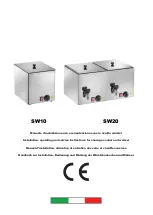
en
How it works
46
‒
Remove the jars from the cooking compartment
after the specified residual heating time.
6.
Vegetables
‒
Once all of the jars are bubbling, reduce the tem-
perature to 120 °C.
‒
Switch off the appliance after the specified resid-
ual heating time and remove the jars from the
cooking compartment.
7.
ATTENTION!
If there are large temperature differences, the jars
may shatter.
▶
Do not place jars on cold or wet surfaces.
▶
Protect the jars from draughts.
Place the jars on a clean cloth and cover them.
8.
Once the jars have cooled, remove the clips.
Recommended settings
Preserving food
The specified times in the table are average values for preserving fruit and vegetables. They may be influenced by
room temperature, the number of jars, quantity, heat and quality of the jar contents. The specifications are based on
1-litre round jars.
Meal
Accessory/
cookware
Shelf posi-
tion
Type of
heating
Temperature
in °C
Cooking time, minutes
Vegetables, beetroot:
1-litre pre-
serving jars
2
1.
170–180
2.
120–140
3.
-
1.
Until bubbling starts
2.
Once it starts bubbling:
35
3.
Residual heat: 30
Vegetables, e.g. cucum-
bers
1-litre pre-
serving jars
2
1.
170–180
2.
-
1.
Until bubbling starts
2.
Residual heat: 35
Vegetables, e.g. Brussels
sprouts
1-litre pre-
serving jars
2
1.
170–180
2.
120–140
3.
-
1.
Until bubbling starts
2.
Once it starts bubbling:
45
3.
Residual heat: 30
Vegetables, e.g. beans,
kohlrabi, red cabbage
1-litre pre-
serving jars
2
1.
170–180
2.
120–140
3.
-
1.
Until bubbling starts
2.
Once it starts bubbling:
60
3.
Residual heat: 30
Vegetables, e.g. peas
1-litre pre-
serving jars
2
1.
170–180
2.
120–140
3.
-
1.
Until bubbling starts
2.
Once it starts bubbling:
70
3.
Residual heat: 30
Stone fruit, e.g. cherries,
apricot, peach, grapes,
gooseberries, damsons
1-litre pre-
serving jars
2
1.
170–180
2.
-
1.
Until bubbling starts
2.
Residual heat: 30
Pomes, e.g. apples, straw-
berries, gooseberries
1-litre pre-
serving jars
2
1.
170–180
2.
-
1.
Until it starts bubbling:
30–40
2.
Residual heat: 25
Pureed fruit, e.g. apples,
pears and plums
1-litre pre-
serving jars
2
1.
170–180
2.
-
1.
Until it starts bubbling:
30–40
2.
Residual heat: 35
29.15 Proving dough
You can prove yeast dough more quickly in your appli-
ance than at room temperature.
Proving dough
Always allow yeast dough to prove in two steps: Once
in its entirety (dough fermentation) and a second time
in the baking tin (final fermentation).
1.
Place the dough into a heat-resistant bowl.
2.
Place the bowl on the wire rack.
3.
Use the recommended settings when configuring
the appliance settings.
Only start operation when the cooking compartment
has fully cooled down.
4.
Do not open the appliance door while the dough is
proving, otherwise moisture will escape.
5.
Continue processing the dough and mould it into
the final shape for baking.
6.
Place the dough into the cooking compartment at
the specified shelf position.
Tip:
If you want to preheat the oven, do not carry out
the final proving stage in the appliance.







































